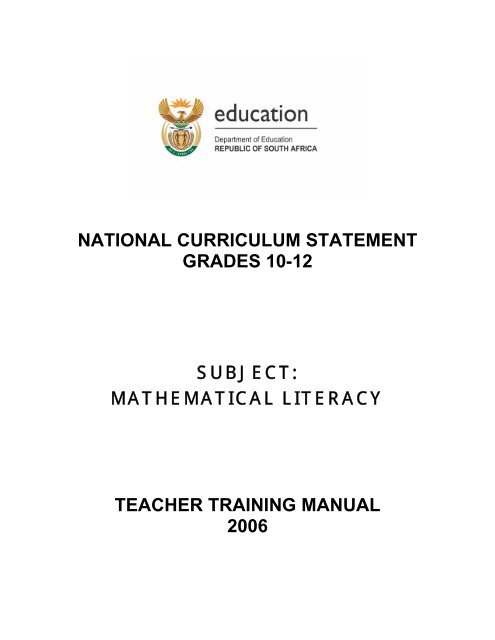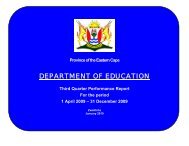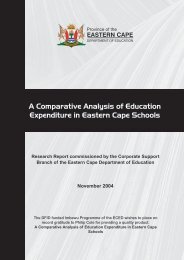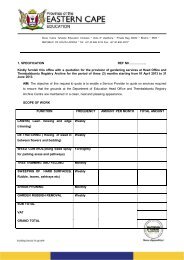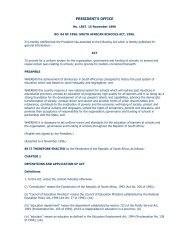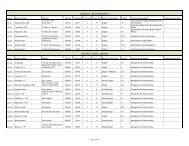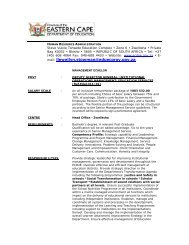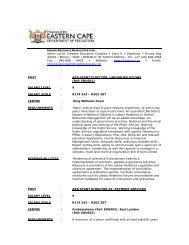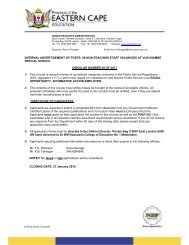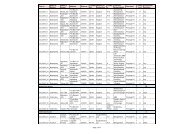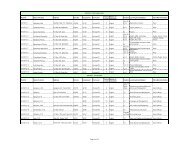Mathematical Literacy - Department of Basic Education
Mathematical Literacy - Department of Basic Education
Mathematical Literacy - Department of Basic Education
Create successful ePaper yourself
Turn your PDF publications into a flip-book with our unique Google optimized e-Paper software.
NATIONAL CURRICULUM STATEMENT<br />
GRADES 10-12<br />
SUBJECT:<br />
MATHEMATICAL LITERACY<br />
TEACHER TRAINING MANUAL<br />
2006
CONTENTS<br />
PROGRAMME 2<br />
SESSION 1 –<br />
Introducing the National Curriculum Statement (NCS) and the National Senior<br />
Certificate (NSC) 3<br />
SESSION 2 –<br />
Introducing the Subject Statement 6<br />
SESSION 3 –<br />
Planning for teaching subjects in the NCS 10<br />
SESSION 4 –<br />
Annual assessment plan 13<br />
ACTIVITY HANDOUTS 15<br />
NCS TEACHER TRAINING MANUAL 2006: MATHEMATICAL LITERACY 1
PROGRAMME<br />
PERIOD:<br />
Monday to Friday<br />
DURATION: 36-37 hours<br />
5-DAY PROGRAMME FOR MATHEMATICAL LITERACY TEACHERS-<br />
SESSION ACTIVITY TIME DAY<br />
1. Introducing the National<br />
Curriculum Statement (NCS)<br />
and the National Senior<br />
Certificate (NSC)<br />
2. Introducing the<br />
<strong>Mathematical</strong> <strong>Literacy</strong><br />
Subject Statement<br />
3. Planning for teaching<br />
<strong>Mathematical</strong> <strong>Literacy</strong> in the<br />
NCS<br />
4. Annual assessment plan<br />
Introduction <strong>of</strong> training<br />
participants<br />
Overview <strong>of</strong> the week <strong>of</strong><br />
training / documents provided<br />
Introduction to the NCS and<br />
NSC<br />
Introduction<br />
Subject Content and<br />
Approach<br />
Conclusion / Wrap-up<br />
The Planning Cycle<br />
The Grade 11 Work Schedule<br />
Critique <strong>of</strong> the Grade 11 Work<br />
Schedule<br />
Development <strong>of</strong> the first<br />
Lesson Plan for Grade 11<br />
Introduction<br />
Annual assessment plan<br />
Conclusion / Wrap-up<br />
3-4 hours Mon AM<br />
20 hours Mon PM –<br />
Wed PM<br />
8 hours Thu<br />
5 hours Fri AM<br />
NCS TEACHER TRAINING MANUAL 2006: MATHEMATICAL LITERACY 2
SESSION 1<br />
Introducing the National Curriculum Statement (NCS) and the National<br />
Senior Certificate (NSC) (3-4 hours)<br />
ACTIVITY 1: Introduction <strong>of</strong> training participants<br />
FORM OF ACTIVITY:<br />
Introductions<br />
ACTIVITY 2: Overview <strong>of</strong> the week <strong>of</strong> training / documents provided<br />
FORM OF ACTIVITY:<br />
RESOURCES:<br />
Presentation<br />
The 5-day training programme (PowerPoint)<br />
A hard copy <strong>of</strong> each document referred to-<br />
• National Senior Certificate Policy<br />
• Subject Statement<br />
• Subject Assessment Guidelines<br />
• Learning Programme Guidelines<br />
• Teacher Guide for <strong>Mathematical</strong> <strong>Literacy</strong><br />
• National Protocol on Assessment<br />
• HE admission requirements<br />
CONTENT:<br />
• Training programme for the week and house rules<br />
• Documents making up the NSC policy and documents supporting the NCS policy –<br />
purpose and status <strong>of</strong> each<br />
ACTIVITY 3: Introduction to the NCS and NSC<br />
Part 1:<br />
20 Questions<br />
FORM OF ACTIVITY:<br />
RESOURCES:<br />
Test and discussion<br />
PowerPoint Presentation, Laptop, Data Projector<br />
CONTENT:<br />
• 20 questions focusing on the NCS and NSC<br />
INSTRUCTIONS:<br />
• Allow the participants to record their responses to each question as individuals<br />
• Discuss the answers with the group as a whole, inviting participants to <strong>of</strong>fer answers<br />
before discussing them<br />
NCS TEACHER TRAINING MANUAL 2006: MATHEMATICAL LITERACY 3
Part 2:<br />
NCS and NSC<br />
FORM OF ACTIVITY:<br />
RESOURCES:<br />
Presentation and discussion<br />
PowerPoint Presentation, Laptop, Data Projector, a hard copy<br />
<strong>of</strong> each document referred to in the presentation-<br />
• National Senior Certificate Policy<br />
• Subject Statement<br />
• Subject Assessment Guidelines<br />
• Learning Programme Guidelines<br />
• National Protocol on Assessment<br />
CONTENT:<br />
• Overview <strong>of</strong> the NCS, including principles and Critical and Developmental Outcomes<br />
• National Senior Certificate: Requirements, structure and details<br />
Part 3:<br />
Requirements for Higher <strong>Education</strong> study<br />
FORM OF ACTIVITY:<br />
Open-book and presentation<br />
RESOURCES: PowerPoint Presentation, Laptop, Data Projector, HE<br />
admission requirements<br />
CONTENT:<br />
• Requirements for certificate, diploma and degree programmes<br />
INSTRUCTIONS:<br />
Introduction<br />
• While the HE document is not part <strong>of</strong> NCS policy, it provides teachers with indicators<br />
on required learner performance in NCS subjects for entry into Higher <strong>Education</strong><br />
• The 3-year NSC programme is the key to Higher <strong>Education</strong> study and teachers need to<br />
be aware <strong>of</strong> the admission requirements for different programmes <strong>of</strong>fered at Higher<br />
<strong>Education</strong> Institutions as they are the conduits between Grade 9 and Higher <strong>Education</strong><br />
study<br />
Open-book activity<br />
• Ask participants to study the HE document and identify the requirements for certificate,<br />
diploma and degree programmes<br />
Report back and discussion<br />
• Allow one report back<br />
• Present the requirements<br />
• Discuss the designated list <strong>of</strong> subjects, noting that learners already have 3 <strong>of</strong> the<br />
designated subjects in their NSC package – two languages and Mathematics or<br />
<strong>Mathematical</strong> <strong>Literacy</strong><br />
NCS TEACHER TRAINING MANUAL 2006: MATHEMATICAL LITERACY 4
At the end <strong>of</strong> this session you will have:<br />
• Noted the design <strong>of</strong> the NCS<br />
• Been exposed to documents making up the NCS<br />
• Gained an understanding <strong>of</strong> the requirements for the National Senior Certificate<br />
• Explored the HE admission requirements<br />
NCS TEACHER TRAINING MANUAL 2006: MATHEMATICAL LITERACY 5
SESSION 2 –<br />
Introducing the Subject Statement (20 hours)<br />
ACTIVITY 1: Income and expenditure (Elsie’s chicken food) (2 hours)<br />
(This activity is based on Teacher Guide Unit Number 1)<br />
FORM OF ACTIVITY:<br />
RESOURCES:<br />
CONTENT:<br />
INSTRUCTIONS:<br />
Group based task<br />
PowerPoint Presentation, Laptop, Data Projector, or overhead<br />
projector, <strong>Mathematical</strong> <strong>Literacy</strong> Teacher Guide, basic<br />
calculators, activity handout(s) (Appendix)<br />
Completion <strong>of</strong> this activity will reveal ways <strong>of</strong> teaching the<br />
following:<br />
• Income and expenditure and exploring the three situations:<br />
• income > expenditure<br />
• Income = expenditure<br />
• Income < expenditure<br />
• <strong>Basic</strong> calculations using a basic calculator<br />
• Income and expenditure statements, and budgets<br />
• Ratio/proportion<br />
• Breakeven points and making a pr<strong>of</strong>it<br />
• Interpreting answers in context<br />
Introduction <strong>of</strong> activities based on Teacher Guide Unit Number<br />
1 by the facilitator.<br />
ACTIVITY 2: Space and Shape (Baking Cookies) (3 hours)<br />
(This activity is based on Teacher Guide Unit number 2)<br />
FORM OF ACTIVITY:<br />
RESOURCES:<br />
CONTENT:<br />
Group based task on physical modelling<br />
PowerPoint Presentation, Laptop, Data Projector, or overhead<br />
projector, <strong>Mathematical</strong> <strong>Literacy</strong> Teacher Guide, pairs <strong>of</strong><br />
scissors, basic calculators, rulers, pairs <strong>of</strong> compasses, 10 × A4<br />
sheets <strong>of</strong> light cardboard and/or paper per group, activity<br />
handout(s) (Appendix)<br />
Completion <strong>of</strong> the “Packing cookies on a baking tray” task will<br />
reveal ways <strong>of</strong> teaching:<br />
• percentage<br />
• rounding <strong>of</strong>f<br />
• measuring<br />
• using construction instruments – ruler and pair <strong>of</strong><br />
compasses<br />
• conversions<br />
NCS TEACHER TRAINING MANUAL 2006: MATHEMATICAL LITERACY 6
• scale drawings<br />
Completion <strong>of</strong> the “Reflection” task will reveal the importance<br />
<strong>of</strong>:<br />
• estimation<br />
• interpretation <strong>of</strong> drawings<br />
• derivation <strong>of</strong> formula/method<br />
Completion <strong>of</strong> the “Meeting the demand” task will reveal ways<br />
<strong>of</strong> teaching:<br />
• ratios<br />
• volumes<br />
• basic calculations<br />
• working with formulae<br />
• interpreting answers<br />
INSTRUCTIONS: Introduction <strong>of</strong> activities based on Teacher Guide Unit number 2<br />
by the facilitator.<br />
ACTIVITY 3: Calculating costs (Telephone cards and public telephones) (4 hours)<br />
(This activity is based on Teacher Guide Unit number 5)<br />
FORM OF ACTIVITY:<br />
RESOURCES:<br />
CONTENT:<br />
Presentation, individual work, group work and discussion<br />
PowerPoint Presentation, Laptop, Data Projector, or overhead<br />
projector, <strong>Mathematical</strong> <strong>Literacy</strong> Teacher Guide, basic<br />
calculators, sheets <strong>of</strong> graph paper (6 sheets per group), activity<br />
handout(s) (Appendix)<br />
Completion <strong>of</strong> this activity will reveal ways <strong>of</strong> teaching the<br />
following:<br />
• <strong>Basic</strong> calculations and use <strong>of</strong> a basic calculator<br />
• Working with formulae<br />
• Selecting information from tables<br />
• Developing formula based on information in tables<br />
• Rate<br />
• Ratio/Proportion<br />
• Rounding down, up and <strong>of</strong>f<br />
• Completing tables <strong>of</strong> values<br />
• Drawing <strong>of</strong> graphs from tables <strong>of</strong> values<br />
• Identifying critical points on graphs<br />
INSTRUCTIONS: Introduction <strong>of</strong> activities based on Teacher Guide Unit number 5<br />
by the facilitator.<br />
NCS TEACHER TRAINING MANUAL 2006: MATHEMATICAL LITERACY 7
ACTIVITY 4: Measuring and calculating (postage – sending mail) (4 hours)<br />
(This activity is based on Teacher Guide Unit number 14)<br />
FORM OF ACTIVITY:<br />
RESOURCES:<br />
CONTENT:<br />
INSTRUCTIONS:<br />
Group based task<br />
PowerPoint Presentation, Laptop, Data Projector, or overhead<br />
projector, <strong>Mathematical</strong> <strong>Literacy</strong> Teacher Guide, basic<br />
calculators, South African Post Office rates brochure (1 per<br />
participant), measuring tapes (1 – 2 per group), kitchen scales<br />
(1 per every 2 groups), rulers, postal items <strong>of</strong> different sizes and<br />
weights, Post Office domestic letter size guide (to be loaned<br />
from a local post <strong>of</strong>fice), activity handout(s) (Appendix)<br />
Completion <strong>of</strong> this activity will reveal ways <strong>of</strong> teaching the<br />
following:<br />
• Measuring length and weight<br />
• Converting between units <strong>of</strong> measurement<br />
• Performing basic calculations<br />
• Using a basic calculator<br />
• Working with and interpreting information presented in<br />
tables<br />
• Developing tables <strong>of</strong> values<br />
• Estimating<br />
• Interpreting answers in contexts<br />
• Constant and variable relationships<br />
• Simple formulae<br />
• Checking answers<br />
• Decision making<br />
Introduction <strong>of</strong> activities based on Teacher Guide Unit number<br />
14 by the facilitator.<br />
ACTIVITY 5: Data Handling (spending energy) (4 hours)<br />
(This activity is based on Teacher Guide Unit number 24)<br />
FORM OF ACTIVITY:<br />
RESOURCES:<br />
CONTENT:<br />
Presentation and discussion<br />
PowerPoint Presentation, Laptop, Data Projector, or overhead<br />
projector, <strong>Mathematical</strong> <strong>Literacy</strong> Teacher Guide, basic<br />
calculators, activity handout(s) (Appendix)<br />
Completion <strong>of</strong> this activity will reveal ways <strong>of</strong> teaching the<br />
following:<br />
• The role <strong>of</strong> energy conservation in our daily lives.<br />
• Collecting, summarising and representation <strong>of</strong> data.<br />
• Other forms <strong>of</strong> data representation.<br />
• Comparing, analysing and critiquing <strong>of</strong> different types <strong>of</strong><br />
data representation.<br />
NCS TEACHER TRAINING MANUAL 2006: MATHEMATICAL LITERACY 8
INSTRUCTIONS:<br />
Introduction <strong>of</strong> activities based on Teacher Guide Unit number<br />
24 by the facilitator.<br />
ACTIVITY 6: Introduction to <strong>Mathematical</strong> <strong>Literacy</strong> (2 hours)<br />
FORM OF ACTIVITY:<br />
RESOURCES:<br />
Reflection, presentation and discussion<br />
PowerPoint Presentation, Laptop, Data Projector, or overhead<br />
projector, <strong>Mathematical</strong> <strong>Literacy</strong> Teacher Guide, Core<br />
Assessment Standards for <strong>Mathematical</strong> <strong>Literacy</strong><br />
CONTENT:<br />
• Overview <strong>of</strong> the subject: Definition, purpose and scope <strong>of</strong> the subject<br />
• Learning Outcomes for the subject<br />
• Incremental implementation <strong>of</strong> the <strong>Mathematical</strong> <strong>Literacy</strong> curriculum<br />
for Grades 10-12 – Core Assessment Standards<br />
• Time allocation and placement <strong>of</strong> <strong>Mathematical</strong> <strong>Literacy</strong> in the school<br />
timetable<br />
• Content in <strong>Mathematical</strong> <strong>Literacy</strong><br />
• Progression in <strong>Mathematical</strong> <strong>Literacy</strong><br />
ACTIVITY 7: Teaching <strong>Mathematical</strong> <strong>Literacy</strong> – dealing with the realities (2 hours)<br />
FORM OF ACTIVITY:<br />
RESOURCES:<br />
Discussion<br />
Newsprint, koki pens and Prestik<br />
CONTENT:<br />
• Discussion <strong>of</strong> the classroom realities and their implications for<br />
teaching <strong>Mathematical</strong> <strong>Literacy</strong><br />
• Support needed to make a success <strong>of</strong> teaching <strong>Mathematical</strong> <strong>Literacy</strong>.<br />
At the end <strong>of</strong> this session you will have:<br />
• Engaged with and analysed the content (i.e. knowledge, skills and values) relevant to<br />
<strong>Mathematical</strong> <strong>Literacy</strong><br />
• Critically explored the teaching, learning and assessment approach relevant to<br />
<strong>Mathematical</strong> <strong>Literacy</strong><br />
• Explored the use <strong>of</strong> the <strong>Mathematical</strong> <strong>Literacy</strong> Teacher Guide in developing lessons for<br />
teaching <strong>Mathematical</strong> <strong>Literacy</strong><br />
NCS TEACHER TRAINING MANUAL 2006: MATHEMATICAL LITERACY 9
SESSION 3 –<br />
Planning for teaching subjects in the NCS (8 hours)<br />
ACTIVITY 1: Introduction to the planning cycle (½ hour)<br />
FORM OF ACTIVITY:<br />
RESOURCES:<br />
Presentation and discussion<br />
PowerPoint Presentation, Laptop, Data Projector<br />
CONTENT:<br />
• Three stages <strong>of</strong> planning<br />
• Purpose, role-players and duration per stage<br />
• Issues to consider when developing a Learning Programme<br />
• Brief overview <strong>of</strong> the key activities and development process per stage<br />
ACTIVITY 2: Introduction to the Grade 11 Work Schedule (1 hour)<br />
FORM OF ACTIVITY:<br />
RESOURCES:<br />
Presentation and discussion<br />
PowerPoint, Laptop, Data Projector, Grade 11 Work Schedule,<br />
Optional: OHP Presentation, OHP Projector, OHP Pens and<br />
OHP Sheets<br />
CONTENT:<br />
• Elements <strong>of</strong> design<br />
• Process <strong>of</strong> design<br />
o Integration: What, how and why<br />
o Sequencing: What, how and why<br />
o Pacing: What, how and why<br />
o Suggested assessment tasks: What and why – will return to this in Session 4<br />
o LTSM: What and why<br />
ACTIVITY 3: Critique the Grade 11 Work Schedule (4½ hours)<br />
FORM OF ACTIVITY:<br />
RESOURCES:<br />
Interactive, report back and discussion<br />
PowerPoint Presentation, Laptop, Data Projector, Subject<br />
Statement, Learning Programme Guidelines<br />
CONTENT:<br />
• Grade 11 Work Schedule<br />
NCS TEACHER TRAINING MANUAL 2006: MATHEMATICAL LITERACY 10
INSTRUCTIONS:<br />
• Participants study the example <strong>of</strong> the Grade 11 Work Schedule provided and critique it:<br />
o Does the Work Schedule cover all the Assessment Standards (i.e. content)?<br />
o Integration: Are the Assessment Standards appropriately linked?<br />
o Are the Assessment Standards covered in sufficient detail and depth?<br />
o Pacing: Is the time allocation across the 40 weeks appropriate?<br />
o Sequencing: Is the content presented in the correct order?<br />
o Are appropriate assessment tasks suggested?<br />
o Are relevant LTSM listed?<br />
o How can the Work Schedule be improved?<br />
ACTIVITY 4: Report back (1 hour)<br />
FORM OF ACTIVITY:<br />
RESOURCES:<br />
Report back and discussion<br />
PowerPoint Presentation, Laptop, Data Projector, Subject<br />
Statement, Learning Programme Guidelines<br />
CONTENT:<br />
• Improved Grade 11 Work Schedule<br />
INSTRUCTIONS:<br />
• Allow different groups to present their improved version <strong>of</strong> the exemplar Work<br />
Schedule for Grade 11<br />
• Engage participants in a discussion after each presentation<br />
ACTIVITY 5: Development <strong>of</strong> the first Lesson Plan for Grade 11 (1 hour)<br />
FORM OF ACTIVITY:<br />
RESOURCES:<br />
Presentation, interactive, report back and discussion<br />
PowerPoint Presentation, Laptop, Data Projector, Subject<br />
Statement, Learning Programme Guidelines, Teacher Guide<br />
CONTENT:<br />
• Grade 11 Lesson Plan<br />
o Elements <strong>of</strong> design<br />
o Process <strong>of</strong> design<br />
INTRODUCTION:<br />
• Lesson Plan: What it is and its duration<br />
• Pointers on deciding on the number <strong>of</strong> Lesson Plans to be written<br />
• Elements and design <strong>of</strong> a Lesson Plan<br />
• Teaching method: What and why<br />
• Assessment strategy: Who, when, how and form <strong>of</strong> assessment<br />
• Expanded opportunities: Inclusive approach to accommodate all learners<br />
• Teacher reflection: What it is and its role in reflective practice<br />
NCS TEACHER TRAINING MANUAL 2006: MATHEMATICAL LITERACY 11
INSTRUCTIONS:<br />
• Provide an overview <strong>of</strong> the elements and the design process <strong>of</strong> a Lesson Plan<br />
• Engage participants in the development <strong>of</strong> the first Lesson Plan that will be presented<br />
for the first 2-5 weeks <strong>of</strong> the school year according to the Grade 11 Work Schedule<br />
critiqued in Activity 3<br />
• Allow one group to present and then discuss their presentation<br />
At the end <strong>of</strong> this session you will have:<br />
• Been introduced to the planning cycle for a Learning Programme<br />
• Been exposed to the elements and design process <strong>of</strong> a Work Schedule and a Lesson<br />
Plan for your subject<br />
• Critiqued and improved an exemplar <strong>of</strong> a Grade 11 Work Schedule<br />
• Developed a Lesson Plan for the first 2-5 weeks for Grade 11<br />
NCS TEACHER TRAINING MANUAL 2006: MATHEMATICAL LITERACY 12
SESSION 4 –<br />
Annual assessment plan (5 hours)<br />
ACTIVITY 1: Introduction to assessment in the NCS (¼ hour)<br />
FORM OF ACTIVITY:<br />
RESOURCES:<br />
Presentation and discussion<br />
PowerPoint Presentation, Laptop, Data Projector, National<br />
Protocol on Assessment<br />
CONTENT:<br />
• Approach to assessment: Norm-referenced and criteria-driven<br />
• Recording process: Global mark per task and no averaging <strong>of</strong> marks to arrive at a total<br />
for the subject<br />
• Reporting process: Grade 7-9 also use 7 codes<br />
• Portfolios: Teacher and learner<br />
ACTIVITY 2: Programme <strong>of</strong> Assessment for Grades 10 and 11<br />
FORM OF ACTIVITY:<br />
RESOURCES:<br />
Presentation and discussion<br />
PowerPoint Presentation, Laptop, Data Projector, Subject<br />
Assessment Guidelines<br />
CONTENT:<br />
• Programme <strong>of</strong> Assessment for Grades 10 and 11 (Section 2 <strong>of</strong> the Subject<br />
Assessment Guidelines): Number <strong>of</strong> tasks<br />
• Nature <strong>of</strong> other tasks: Forms <strong>of</strong> assessment suitable to the subject (Section 3 <strong>of</strong> the<br />
Subject Assessment Guidelines) and suitable tools<br />
• Weighting <strong>of</strong> tasks<br />
ACTIVITY 3: Development <strong>of</strong> a Grade 11 annual assessment plan<br />
FORM OF ACTIVITY:<br />
RESOURCES:<br />
Presentation, interactive and discussion<br />
PowerPoint Presentation, Laptop, Data Projector, Subject<br />
Assessment Guidelines<br />
CONTENT:<br />
• Programme <strong>of</strong> Assessment for Grade 11: Tasks, topics, tools and dates<br />
INSTRUCTIONS:<br />
• Ask participants to revisit the Grade 11 Work Schedule (Session 3: Activity 3) and to<br />
align the annual assessment plan for Grade 11 with it<br />
NCS TEACHER TRAINING MANUAL 2006: MATHEMATICAL LITERACY 13
• Engage participants in the compilation <strong>of</strong> a Grade 11 annual assessment plan in which<br />
they indicate:<br />
o Eight tasks: 2 Tests, 2 examinations and 4 other tasks<br />
o Topics for each task<br />
o Assessment tools for each task<br />
o Date and duration <strong>of</strong> each task<br />
At the end <strong>of</strong> this session you will have:<br />
• Exposed to assessment practice in the NCS<br />
• Gained an understanding <strong>of</strong> the elements making up a Programme <strong>of</strong> Assessment<br />
• Developed an annual assessment plan for Grade 11<br />
NCS TEACHER TRAINING MANUAL 2006: MATHEMATICAL LITERACY 14
ACTIVITY HANDOUTS<br />
Session 1 – Activity 3: Twenty Questions<br />
No.<br />
Answer<br />
1<br />
2<br />
3<br />
4<br />
5<br />
6<br />
7<br />
8<br />
9<br />
10<br />
11<br />
12<br />
13<br />
14<br />
15<br />
16<br />
17<br />
18<br />
19<br />
20<br />
NCS TEACHER TRAINING MANUAL 2006: MATHEMATICAL LITERACY 15
Session 2 – Activity 1: Budgets (Elsie’s chicken food)<br />
The most basic and important concepts to understand with respect to personal finance<br />
are income and expenditure. If income exceeds expenditure then we have money to save;<br />
if income equals expenditure we break even and if expenditure exceeds income we will<br />
have to use up our savings, or worse, go into debt.<br />
Elsie, like many women across South Africa, makes a living by selling chicken food, fruit<br />
and vegetables on the side <strong>of</strong> the street and in markets.<br />
Task 1:<br />
Based on the information about Elsie’s stall provided in the Teacher Guide<br />
(p. 7) calculate the cost 1 <strong>of</strong> the following items:<br />
• Each <strong>of</strong> the different buckets <strong>of</strong> chicken food,<br />
• A packet <strong>of</strong> potatoes.<br />
1 At this stage we are only interested in calculating the price <strong>of</strong> the item<br />
based on what Elsie has paid for the components.<br />
Task 2:<br />
Task 3:<br />
Task 4:<br />
Task 5:<br />
Income<br />
Based on the information provided for Elsie’s chicken food stall (Teacher<br />
Guide, p. 7) and your own sense <strong>of</strong> Elsie’s stall, make a list <strong>of</strong> the different<br />
forms <strong>of</strong> income that Elsie’s stall could experience.<br />
Expenses<br />
Based on the information provided for Elsie’s chicken food stall (Teacher<br />
Guide, p. 7) and on your own experience, make a list <strong>of</strong> the different<br />
expenses that Elsie is likely to experience in running her stall.<br />
Develop a simple income and expenditure statement (estimating the values)<br />
for a week in the life <strong>of</strong> Elsie’s stall.<br />
Based on your income and expenditure statement decide which <strong>of</strong> the<br />
statements below best describes Elsie’s chicken feed stall. Be ready to justify<br />
your answer.<br />
Income < Expenses<br />
Income = Expenses<br />
Income > Expenses<br />
NCS TEACHER TRAINING MANUAL 2006: MATHEMATICAL LITERACY 16
Session 2 – Activity 2: Baking Cookies – Space and Shape<br />
Background Information<br />
Round and square cookies - dimensions<br />
6cm<br />
Top View<br />
9mm<br />
Side View<br />
Requirements for packing cookies on a baking tray:<br />
Width + 10%<br />
Width<br />
Diam. Diam. + 10%<br />
Baking tray dimensions<br />
Baking trays with the following dimensions can be bought from most supermarkets (other<br />
dimensions are also available):<br />
Tray 1: 440 mm × 290 mm × 15 mm<br />
Tray 2: 385 mm × 260 mm × 13 mm<br />
Tray 4: 335 mm × 235 mm × 15 mm<br />
Different possible packing arrangements for cookies on a baking tray:<br />
NCS TEACHER TRAINING MANUAL 2006: MATHEMATICAL LITERACY 17
Packing cookies on a baking tray<br />
Task 1:<br />
Draw scale drawings <strong>of</strong> the square and circular cookies, and cut at least 30 <strong>of</strong> each <strong>of</strong><br />
these out (let the scale drawings include the expansion distance).<br />
Task 2:<br />
Draw scale drawings for the three baking trays described above.<br />
Task 3:<br />
Use your scale cut-outs for the cookies to explore how many round cookies and how many<br />
square cookies can be baked at a time on each <strong>of</strong> the baking trays. Make a table to record<br />
your findings<br />
Reflection<br />
Reflect on the processes used to determine the maximum number <strong>of</strong> cookies per tray.<br />
Can you think <strong>of</strong> an easier method to determine<br />
o the number <strong>of</strong> square cookies, and<br />
o the number <strong>of</strong> round cookies?<br />
Meeting the demand<br />
Task 4:<br />
Determine the volume <strong>of</strong> the square and the round cookie.<br />
_____________________________________________________________<br />
_____________________________________________________________<br />
_____________________________________________________________<br />
_____________________________________________________________<br />
_____________________________________________________________<br />
Task 5:<br />
If a 200g packet <strong>of</strong> square cookies has 19 cookies in it, how many cookies<br />
will there be in 200g packet <strong>of</strong> round cookies? Be ready to explain your<br />
answer.<br />
____________________________________________________________<br />
____________________________________________________________<br />
____________________________________________________________<br />
____________________________________________________________<br />
_____________________________________________________________<br />
NCS TEACHER TRAINING MANUAL 2006: MATHEMATICAL LITERACY 18
Task 6:<br />
How many <strong>of</strong> each kind will there be in a 250g packet?<br />
Be ready to explain your answer.<br />
____________________________________________________________<br />
____________________________________________________________<br />
____________________________________________________________<br />
____________________________________________________________<br />
Task 7:<br />
(As a teacher) Develop at least three variations on the two problems listed<br />
above (with solutions).<br />
____________________________________________________________<br />
____________________________________________________________<br />
____________________________________________________________<br />
____________________________________________________________<br />
NCS TEACHER TRAINING MANUAL 2006: MATHEMATICAL LITERACY 19
Activity 3: The cost <strong>of</strong> using a Telkom Public phone<br />
Telephone call charges from<br />
public phones<br />
Rand<br />
Rand<br />
(excl VAT) (incl. VAT)<br />
Unit charge per metering period 0,439 0,50<br />
Calls to Telkom phones<br />
Standard time:<br />
Monday to Friday 07:00 to 19:00<br />
Metering period in seconds<br />
Callmore time:<br />
Monday to Friday 19:00 to 07:00<br />
and Friday 19:00 to Monday 07:00<br />
Local (0-50 km) 58,0 110,0<br />
Long distance (> 50km) 20,7 38,5<br />
Metering period in seconds<br />
Calls to mobile cellular phones<br />
source: www.telkom.co.za<br />
Rate 1:<br />
Weekdays from 07:00 to 20:00<br />
Rate 2:<br />
Monday to Friday 20:00 to 07:00<br />
and Friday 20:00 to Monday 07:00<br />
11,2 17,6<br />
Task 1:<br />
Use the table and calendar provided to answer the following questions.<br />
WORK AS AN INDIVIDUAL<br />
1.1 What is the VAT inclusive charge for a<br />
metering period?<br />
1.2 At which <strong>of</strong> the following rates<br />
(Standard, Callmore, Rate 1 or Rate 2)<br />
will the following calls be charged?<br />
(a) To Telkom at 16:00 on 26/04/05<br />
(b) To Telkom at 19:30 on 26/04/05<br />
(c) To Cellular at 19:30 on 26/04/05<br />
(d) To Telkom at 13:00 on 27/04/05<br />
(e) To Telkom at 13:00 on 30/04/05<br />
(f) To Cellular at 08:00 on 07/05/05<br />
April 2005<br />
Sun Mon Tue Wed Thu Fri Sat<br />
1 2<br />
3 4 5 6 7 8 9<br />
10 11 12 13 14 15 16<br />
17 18 19 20 21 22 23<br />
24 25 26 27 28 29 30<br />
WORKING AS A GROUP<br />
1.3 How long is the metering period for each <strong>of</strong> the following calls?<br />
(a) To Telkom (45km) at 16:00 on 15/04/05<br />
(b) To Cellular phone at 16:00 on 15/04/05<br />
(c) To Telkom (98km) at 19:30 on 16/04/05<br />
(d) To Cellular phone at 19:30 on 16/04/05<br />
(e) To Telkom (15km) at 11:30 on 17/04/05<br />
(f) To Cellular at 11:30 on 17/04/05<br />
(g) To Telkom (1125km) at 14:00 on 18/04/05<br />
(h) To Cellular at 14:00 on 18/04/05<br />
NCS TEACHER TRAINING MANUAL 2006: MATHEMATICAL LITERACY 20
1.4 How much will each <strong>of</strong> the following calls cost?<br />
(a) To Telkom (45km) at 20:00 on 15/04/05 duration 7 minutes<br />
(b) To Cellular phone at 20:00 on 15/04/05 duration 7 minutes<br />
(c) To Telkom (78km) at 16:00 on 07/04/05 duration 4 minutes<br />
(d) To Cellular phone at 16:00 on 07/04/05 duration 4 minutes<br />
1.5 How many days will a R20,00 Telkom phone card last if you make a local call<br />
everyday for 5 minutes during Callmore time to another Telkom phone?<br />
Task 2:<br />
Complete the table below.<br />
Number <strong>of</strong> units for<br />
different<br />
telephone calls<br />
Call duration (minutes)<br />
0,5 1 1,5 2 2,5 3 3,5 4 4,5<br />
To Telkom<br />
Std<br />
time<br />
Local<br />
Long<br />
distance<br />
Callmo Local<br />
re<br />
time Long<br />
distance<br />
To mobile<br />
numbers<br />
Rate 1<br />
Rate 2<br />
Task 3:<br />
Use the table you have completed and the graph paper provided to draw a<br />
graph which depicts the information from the first row <strong>of</strong> the table.<br />
PLEASE DO NOT PROCEED TO TASK 4 UNTIL AFTER THE PLENARY DISCUSSION<br />
ON TASK 3.<br />
Task 4:<br />
Use the table you have completed and the new piece <strong>of</strong> graph paper<br />
provided to draw a graph which depicts the information for one further row <strong>of</strong><br />
the table.<br />
NCS TEACHER TRAINING MANUAL 2006: MATHEMATICAL LITERACY 21
Session 2 – Activity 4: Measuring and calculating (postage – sending mail)<br />
Task 1: Determining dimensions<br />
You have been supplied with a measuring tape, and have access to a kitchen scale.<br />
For each <strong>of</strong> the items supplied please determine the dimensions necessary to complete<br />
the table below.<br />
Item number Length (mm) Breadth (mm)<br />
Diameter<br />
1<br />
2<br />
3<br />
4<br />
5<br />
6<br />
7<br />
8<br />
9<br />
10<br />
11<br />
12<br />
13<br />
14<br />
15<br />
16<br />
17<br />
18<br />
19<br />
20<br />
Height (mm)<br />
Weight (grams)<br />
NCS TEACHER TRAINING MANUAL 2006: MATHEMATICAL LITERACY 22
Session 2 – Activity 4: Measuring and calculating (postage – sending mail)<br />
Task 2: Local mail costs<br />
You have been supplied with a Post Office rates brochure refer to the appropriate page(s)<br />
and classify each <strong>of</strong> the postal items on your list and determine both the ordinary mail and<br />
Fastmail costs for mailing the items.<br />
Item number Classification Ordinary mail cost Fastmail cost<br />
1<br />
2<br />
3<br />
4<br />
5<br />
6<br />
7<br />
8<br />
9<br />
10<br />
11<br />
12<br />
13<br />
14<br />
15<br />
16<br />
17<br />
18<br />
19<br />
20<br />
NCS TEACHER TRAINING MANUAL 2006: MATHEMATICAL LITERACY 23
Session 2 – Activity 4: Measuring and calculating (postage – sending mail)<br />
Task 3: International mail costs<br />
You have been supplied with a Post Office rates brochure refer to the appropriate page(s)<br />
and classify each <strong>of</strong> the postal items on your list and determine the costs <strong>of</strong> sending the<br />
item to (a) a country in Southern Africa and (b) a country in the “rest <strong>of</strong> the world.”<br />
Item number<br />
International mail<br />
classification<br />
Southern Africa<br />
mailing cost<br />
“Rest <strong>of</strong> the world”<br />
mailing cost<br />
1<br />
2<br />
3<br />
4<br />
5<br />
6<br />
7<br />
8<br />
9<br />
10<br />
11<br />
12<br />
13<br />
14<br />
15<br />
16<br />
17<br />
18<br />
19<br />
20<br />
NCS TEACHER TRAINING MANUAL 2006: MATHEMATICAL LITERACY 24
Session 2 – Activity 5: Burning Energy<br />
Task 1:<br />
Complete a burning energy log sheet for a typical weekday in your life.<br />
Please note:<br />
• You must do each <strong>of</strong> the activities for at least half an hour, and<br />
• You cannot do more than one activity at the same time<br />
Task 2:<br />
Representing data – pie charts<br />
• Draw a personal pie chart (using time spend) that shows the different<br />
activities in your typical day.<br />
• Draw a personal pie chart that shows how you burnt energy in your<br />
typical day.<br />
Task 3:<br />
Representing data – compound bar graphs<br />
• Participation in different activities: Combine the data for your group and<br />
draw a double bar graph that compares the participation in five<br />
different activities by yourself with that <strong>of</strong> the group.<br />
• Energy spent through different activities: Combine the data for your<br />
group and draw a double bar graph that compares the energy spent on<br />
five different activities by yourself with that <strong>of</strong> the group.<br />
Task 4:<br />
Comparing different types <strong>of</strong> representation<br />
By looking at the different representations you have developed, compare the<br />
advantages and disadvantages <strong>of</strong> each <strong>of</strong> the forms <strong>of</strong> representation.<br />
____________________________________________________________<br />
____________________________________________________________<br />
____________________________________________________________<br />
____________________________________________________________<br />
NCS TEACHER TRAINING MANUAL 2006: MATHEMATICAL LITERACY 25
Burning Energy – individual data collection sheet<br />
Every activity that we engage in every day burns energy. Complete the log below for a typical week-day.<br />
ACTIVITY<br />
kJ/h<br />
Total<br />
time<br />
Total<br />
kJ<br />
0h00 1h00 2h00 3h00 4h00 5h00 6h00 7h00 8h00 9h00 10h00 11h00 12h00 13h00 14h00 15h00 16h00 17h00 18h00 19h00 20h00 21h00 22h00 23h00<br />
Arguing with somebody 440<br />
Dancing (active) 1675<br />
Driving a car 500<br />
Eating a meal 585<br />
Exercise, some sweating 1045<br />
Gardening (lawn mowing) 1235<br />
Gardening (weeding) 960<br />
Grocery shopping 375<br />
Housework (light) 395<br />
Housework (heavy) 940<br />
Playing in the garden 440<br />
Showering 1090<br />
Sitting (reading, writing, TV) 315<br />
Sitting (talking, concentrating) 500<br />
Sleeping 250<br />
Sport (light) 1425<br />
Sport (medium) 1610<br />
Sport (heavy) 2930<br />
Standing still 420<br />
Walking (comfortable pace) 545<br />
Walking (fast) 1780<br />
Working sitting (using a machine) 335<br />
Working standing and walking 850<br />
Working (hard manual labour) 1020<br />
Total<br />
NCS TEACHER TRAINING MANUAL 2006: MATHEMATICAL LITERACY 26
Time spent on daily activities by Marc<br />
Energy Burned by Marc<br />
Working sitting,<br />
9.5 hours<br />
Eating,<br />
1.5 hours<br />
Housework, 1.5<br />
hours<br />
Playing in the<br />
garden, 0.5 hours<br />
Showering,<br />
0.5 hours<br />
Sitting,<br />
2 hours<br />
Working sitting,<br />
3182.5 kJ<br />
Eating,<br />
877.5 kJ<br />
Housework,<br />
592.5 kJ<br />
Playing in the<br />
garden, 220 kJ<br />
Showering,<br />
545 kJ<br />
Sitting,<br />
630 kJ<br />
Sport (medium),<br />
1 hours<br />
Sleeping,<br />
8 hours<br />
Sport (medium),<br />
1610 kJ<br />
Sleeping,<br />
2000 kJ<br />
NCS TEACHER TRAINING MANUAL 2006: MATHEMATICAL LITERACY 27
Burning Energy – group data collection sheet<br />
Member 1 Member 2 Member 3 Member 4<br />
Group<br />
average<br />
ACTIVITY<br />
kJ/h<br />
Total<br />
time<br />
Total<br />
kJ<br />
Total<br />
time<br />
Total<br />
kJ<br />
Total<br />
time<br />
Total<br />
kJ<br />
Total<br />
time<br />
Total<br />
kJ<br />
Total<br />
time<br />
Total<br />
kJ<br />
Total<br />
time<br />
Total<br />
kJ<br />
Total<br />
time<br />
Total<br />
kJ<br />
Total<br />
time<br />
Total<br />
kJ<br />
Total<br />
time<br />
Total<br />
kJ<br />
Total<br />
time<br />
Total<br />
kJ<br />
Total<br />
time<br />
Total<br />
kJ<br />
Total<br />
time<br />
Total<br />
kJ<br />
Total<br />
time<br />
Total<br />
kJ<br />
Arguing with somebody 440<br />
Dancing (active) 1675<br />
Driving a car 500<br />
Eating a meal 585<br />
Exercise, some sweating 1045<br />
Gardening (lawn mowing) 1235<br />
Gardening (weeding) 960<br />
Grocery shopping 375<br />
Housework (light) 395<br />
Housework (heavy) 940<br />
Playing in the garden 440<br />
Showering 1090<br />
Sitting (reading, writing, TV) 315<br />
Sitting (talking, concentrating) 500<br />
Sleeping 250<br />
Sport (light) 1425<br />
Sport (medium) 1610<br />
Sport (heavy) 2930<br />
Standing still 420<br />
Walking (comfortable pace) 545<br />
Walking (fast) 1780<br />
Working sitting (using a machine) 335<br />
Working standing and walking 850<br />
Working (hard manual labour) 1020<br />
NCS TEACHER TRAINING MANUAL 2006: MATHEMATICAL LITERACY 28
Session 2 – Content, Context & Competencies<br />
content—context—competencies<br />
<strong>Mathematical</strong> <strong>Literacy</strong><br />
NCS TEACHER TRAINING MANUAL 2006: MATHEMATICAL LITERACY 29


